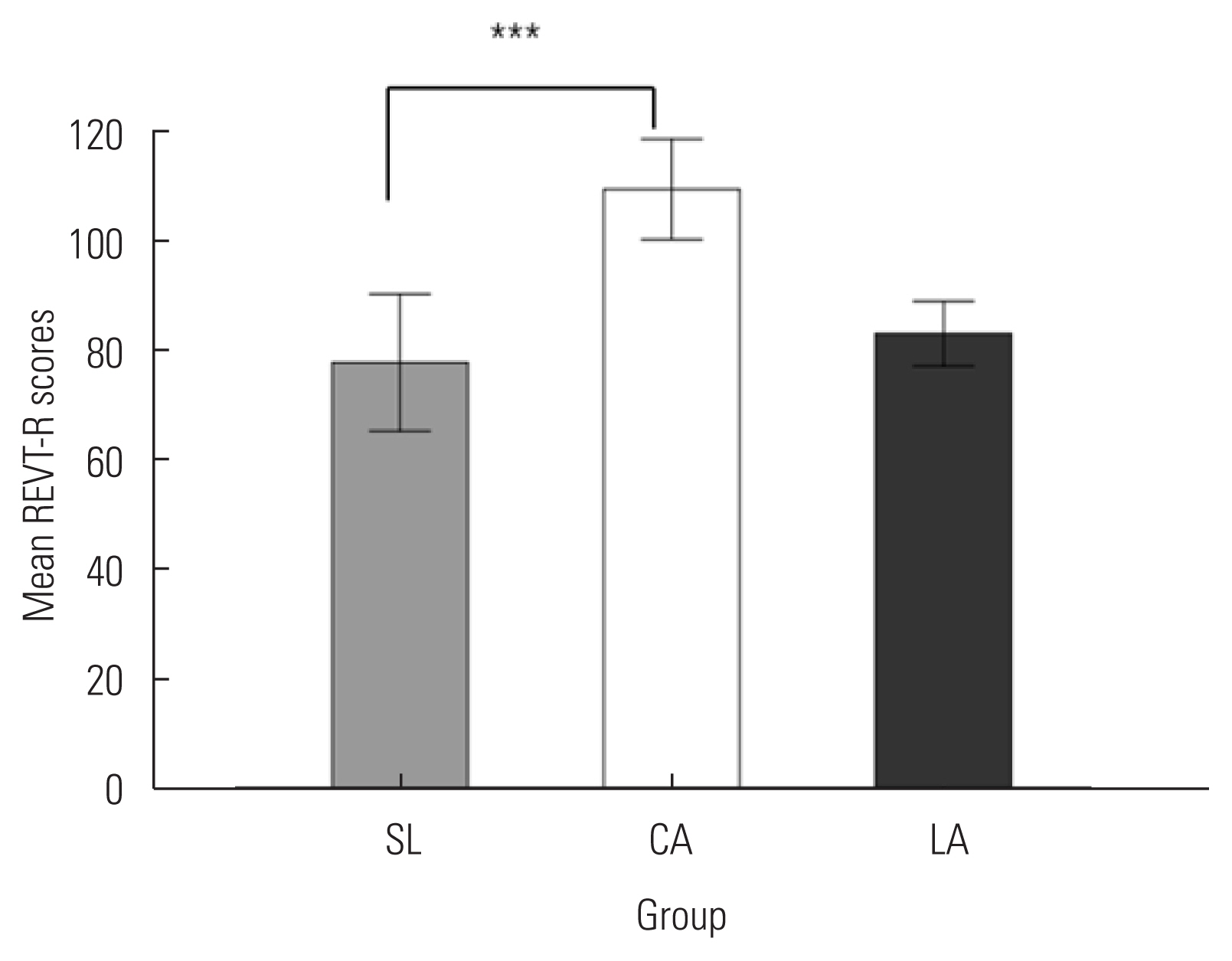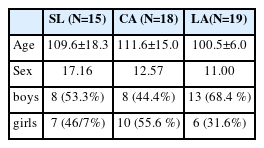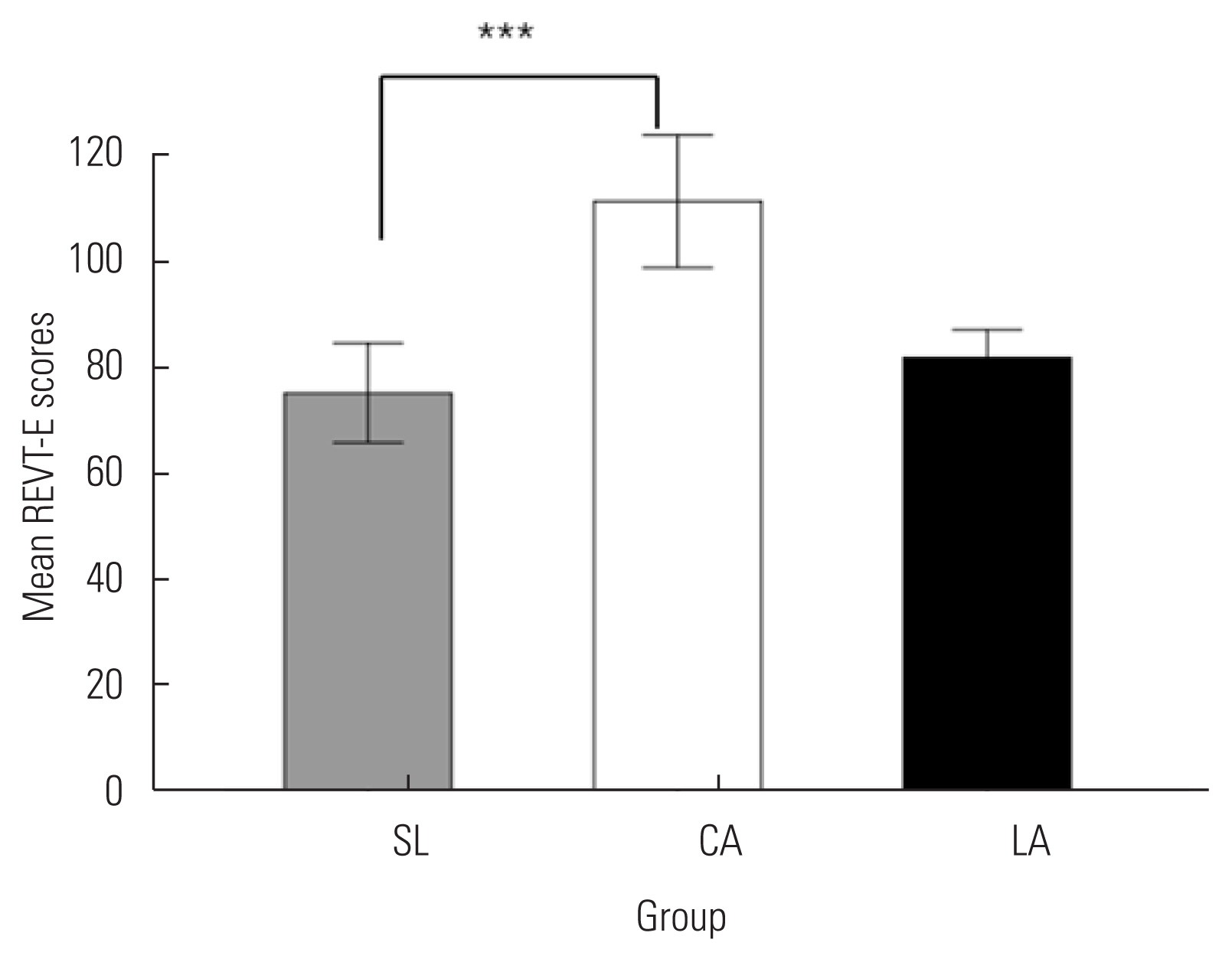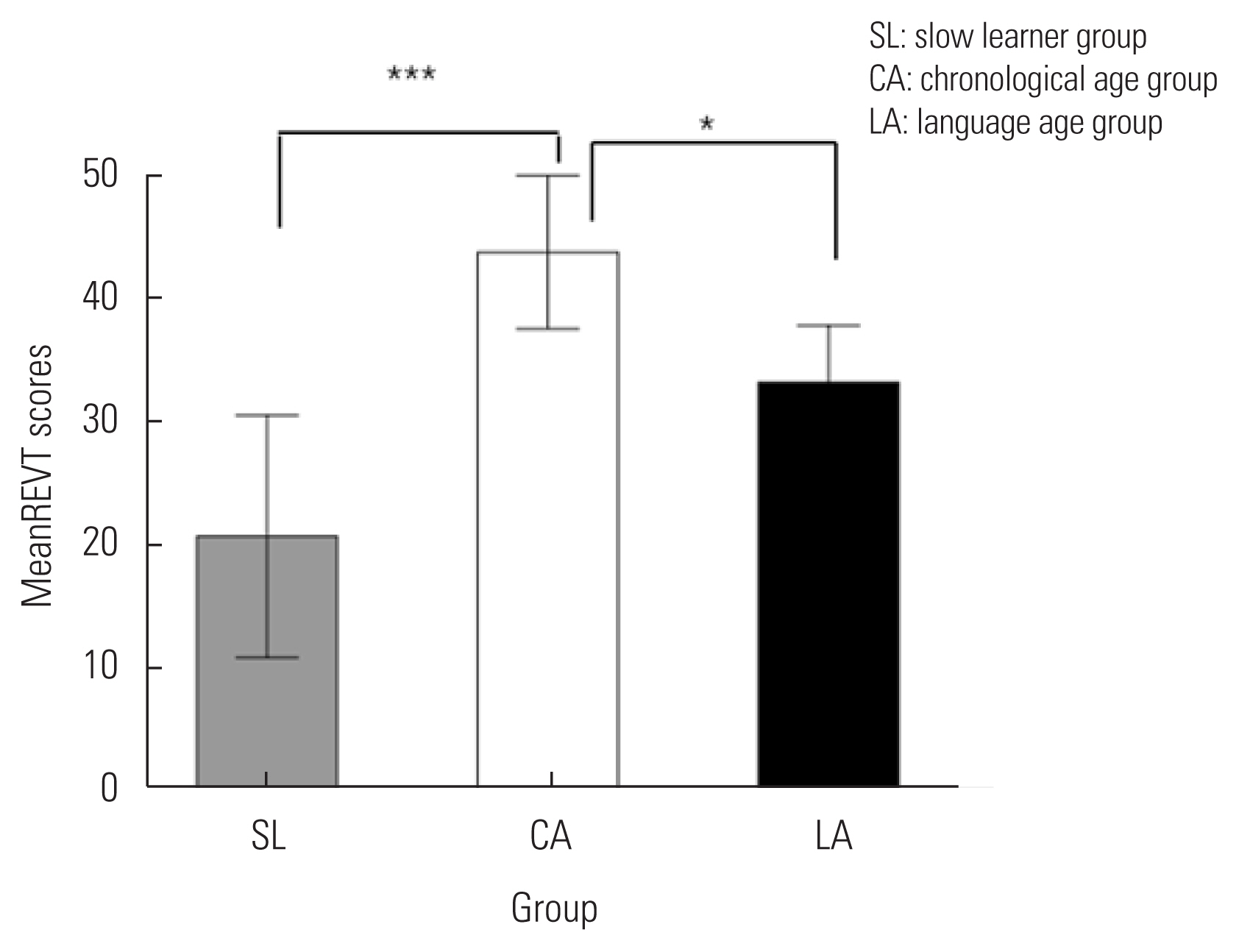Comparison Metaphor and Reasoning Comprehension Between Children with Borderline Intelligence and Typical Developing School-Aged children
Article information
Abstract
Purpose
Metalinguistic skills play a critical role in school-aged children’s language development and academic achievement. This study investigates whether metaphorical reasoning in children with borderline intellectual functioning (BIF) (or slow learners) differs from that of typically developing children.
Methods
A total of 52 children (29 boys and 23 girls), who voluntarily agreed to participate in the study, were included. Children were categorized into three groups (15 slow learner group, 18 chronological age-matched group, and 19 language age-matched group) based on their K-WISC and receptive vocabulary scores in the Receptive and Expressive Vocabulary Test (REVT). All children completed the Metaphorical and Reasoning Comprehension test (MARC) to estimate their metaphor and reasoning comprehension ability.
Results
As a result of a one-way analysis of variance, there was a significant difference among the groups, and a significant difference was found between the slow learners and the chronological age-matched group (p=0.000), but no significant difference was presented between the slow learner group and the language age-matched group. Similarly, regarding the expressive vocabulary score, a one-way ANOVA revealed a significant difference only between the slow learner and the chronological age-matched group (p=0.000). When comparing the scores for metaphorical reasoning comprehension among the three groups, the metaphorical reasoning comprehension scores were significantly different among the groups, with the slow learners having the lowest scores: the slow learner group was substantially different from the language age-matched group (p=0.025), while there was also a significant difference between the slow learner group and the chronological age-matched group (p=0.000).
Conclusions
This study suggests that the semantic component of language is not affected in BIF children, but rather, the meaning of words is affected by tasks that require higher-order metalinguistic skills, such as understanding metaphorical inferences embedded in the context of a sentence. Accordingly, the ability to understand metaphorical reasoning can identify slow learners.
INTRODUCTION
According to the Diagnostic and Statistical Manual of Mental Disorders, fourth edition, American Psychiatric Association (DSM-IV, 2000), borderline intelligence is defined as having an IQ above 70 and below 85 [1], with a prevalence of 12% of the population [2,3]. It refers to a person with some impairment in adaptive skills but not as severe as intellectual disability [4]. Poor academic performance [4–7] including difficulties with reading and arithmetic [8,9] due to weak executive functions, and short-term and working memory [10], communication problems, and social problems [7] also accompany it. A recent prospective study of children and adolescents with borderline intelligence reported developmental delays in language and motor development and, at school age, difficulties with executive functioning, reading, and arithmetic. In addition, despite the absence of a poor learning environment or psychiatric disorder, 92% of the study population requires educational support [15].
In this context, school-age BIF children are vulnerable to high risk for various problems, and these borderline intelligence children are estimated to reach about 800,000 nationwide, with three children per class in Korea [16,17]. Because they do not meet the criteria for intellectual disability or specific language impairment, they are placed in regular classes, and their parents and teachers often do not recognize their problems quickly enough to intervene and have them diagnosed. However, borderline intelligent children show difficulties not only in fundamental learning skills but also in higher metalinguistic skills and reading and writing skills and are eventually classified as learning disabled [11]. In addition, as they reach higher grades, they have difficulty acquiring higher language skills and reading and writing skills compared to normal children and are classified as learning disabled [18]. Language development starts with vocabulary and progresses sequentially and simultaneously to higher language. Metaphorical and inferential skills develop rapidly during school age, but it is not easy to specify when metaphorical and inferential skills develop. Some studies suggest it develops before school age [20–23]. At the same time, others suggest that it develops gradually throughout childhood, adolescence, and adulthood [12].
Vocabulary, syntax, and discourse are essential to improve language skills, but higher-order language skills such as phonological awareness and understanding metaphors and metonymy are also necessary. In particular, difficulties in metaphorical reasoning are highly prevalent in children with language disorders, and as children reach school age, these difficulties affect their academic and communication skills. This study aims to investigate how the metaphorical reasoning ability of borderline-intelligent children differs from that of normal children.
METHODS
Participants
In this study, a total of 51 participants were enrolled in the Korean Wechsler Intelligence Scale-IV (K-WISC-IV) [25] for students measured by standardized intelligence tests, including 15 borderline intelligence children with intelligence indices between 70 and 85, 18 chronological age-matched children with typical intelligence, and 19 language age-matched children. The demographic information of the participating children is shown in Table 1.
Evaluation tools
The language test evaluated receptive and expressive vocabulary with Receptive & Expressive Vocabulary Test (REVT) [26], while a Metaphor and Reasoning Comprehension Test (MARC) [27] was conducted to investigate the ability of elementary school children to infer metaphors.
Study procedures
In this study, borderline intelligent children were tested in the treatment rooms of individual clinics. Age-matched children and language-matched children were tested in elementary schools. All children voluntarily agreed to participate in the study. The language tests were conducted one-on-one with the child in a quiet room. They included the K-WISC-IV, the REVT for receptive and expressive vocabulary, and the MARC test.
The MARC test was conducted from the first sentence to the last sentence and took 20–30 minutes. The researcher sat face-to-face with the child and presented the pictures to the child. The researcher read the target sentence once, repeated it if the child asked to hear it again, and asked the child to identify one of the three pictures correctly. All responses were recorded directly on a recording sheet and scored after testing. One point was awarded for each correct answer to calculate the total score.
Statistical analyses
A one-way analysis of variance was conducted to determine the differences in REVT and MARC scores for the three different groups (slow learners group, chronological age-matched group, and language age-matched group), while a Bonferroni test was used to assess the significant main effect of group condition. IBM SPSS version 25.0 (IBM Corp., Armonk, NY, USA) was used for statistical analyses, and a significance level of 0.05 was used.
RESULTS
Comparison of Korean REVT scores by groups
Tables 2 and 3 show the descriptive statistics of the slow learners’ receptive and expressive vocabulary scores, the chronological age-matched children group, and the language age-matched group. In the case of the receptive vocabulary score, the score of the slow learners group was the lowest, followed by the language age-matched group and the chronological age-matched group. As a result of one-way ANOVA, there was a significant difference between the groups (F(2, 49)=15.482, p=0.000). As a result of Bonferroni’s post-test, there was a substantial difference between the slow learners group and the chronological age-matched group (p=.000). Still, there was no significant difference between the slow learners group and the language age-matched group (Table 2, Figure 1).

Comparison of receptive vocabulary scores among the groups., SL, slow learner group; CA, chronological age-matched group; LA, language age-matched group. ***p<.001.
Similarly, the expressive vocabulary score was lowest in the slow learners group, followed by the language age-matched and chronological age-matched groups.
A one-way ANOVA revealed a significant difference between the groups (F(2, 49)=18.425, p=.000), and a post hoc test revealed a significant difference only between the slow learners and the chronological age-matched group (p=.0000) (Table 3, Figure 2).
Comparison of metaphorical reasoning comprehension scores among the groups
The means and standard deviations of the metaphorical reasoning comprehension scores for the three groups are shown in Table 4.
The chronological age-matched group had the highest metaphorical reasoning comprehension scores among the three groups, followed by the language age-matched group and the slow learners group. A one-way analysis of variance showed that the metaphorical reasoning comprehension scores were significantly different between the groups, with the slow learners having the lowest scores. Post hoc tests showed that the slow learners group was substantially different from the language age-matched group (p=0.025), while there was also a significant difference between the slow learners group and the chronological age-matched group (p=0.000) (Table 4) (Figure 3).
Correlations between REVT receptive and expressive vocabulary scores and MARC scores across groups
In the slow learners group, there was a significant positive correlation between the REVT receptive score and the MARC score (r=0.650, p=0.009) and a high positive correlation with the REVT expressive score (r=0.811, p=0.000). In the chronological age-matched group, there was a significant positive correlation between REVT receptive and MARC scores (r=0.617, p=0.006) and a moderate positive correlation with REVT expressive scores (r=0.537, p=0.022). In addition, there was a significant positive correlation between REVT receptive and MARC scores (r=0.592, p=0.008) and no significant correlation with REVT expressive scores in the language age-matched group (r=0.295, p=0.220).
DISCUSSION AND CONCLUSIONS
The present study compared the metaphorical reasoning ability of borderline intelligent children and normal children to determine whether metaphorical reasoning comprehension can identify slow learners known as borderline intelligent. The main characteristics of borderline intelligent children include poor working memory and executive functioning, problems with knowledge organization, difficulties with generalization, poor attention, difficulties with verbal expression and listening, lack of motivation to learn, and behavioral deficits [28–30].
Previous studies have examined the impact of cognitive functions such as working memory and executive functioning on academic achievement in specific domains such as reading or compared profiles on the subtests of the WISC among groups of borderline intelligent children, children with learning disabilities, intellectual disabilities, and typical developing children [31,32], and teachers have found it challenging to identify slow learners in the classroom outside of intelligence tests. The WISC-IV is the most commonly used standardized test to assess intelligence in children aged 6 to 16 [25]. It has been used to determine learning disabilities, intellectual disabilities, and borderline intelligence and to improve educational planning. They are relatively time-consuming, usually lasting between 1.5 and 2 hours on average, and are timed tests, meaning that the child must answer questions within a certain amount of time. This can increase the child’s concentration and stress, affecting the results.
Recent studies using the WISC-IV have found that children with specific learning disabilities (SLD) have higher spoken language comprehension and perceptual reasoning scores than working memory or processing speed scores. In contrast, the borderline intellectual functioning (BIF) group has a profile similar to that of the SLD group, and typically developing children have a profile that does not differ between the four scales [33–36]. However, among the subtests of intelligence tests, the verbal language comprehension test is the ability to use language comprehension, concepts, and word knowledge, similar to the Korean REVT. In addition, the Perceptual Reasoning Test measures non-verbal reasoning skills such as slicing, finding familiar pictures, and matrix reasoning, so it is not easy to measure language-related reasoning skills.
Metalinguistic competence is the ability to adapt content to context or infer, implement, and integrate hidden meanings in communicative situations in various contexts. It is strongly related to learning based on multiple linguistic knowledge and literacy skills. It begins at two or three and develops as children enter school.
This study used the MARC test to compare the verbal metaphorical reasoning comprehension ability of borderline intelligent children, chronological age-matched group, and language age-matched group. The results showed that the BIF group differed significantly from the age-matched group. The language age-matched group was also statistically significantly different from the age-matched group. This result is not surprising as the chronological age-matched group has lower intellectual ability than the BIF group even if they are the same age as the chronological age-matched group. However, the BIF group did not show significant differences in REVT scores with the language age-matched group, but they did show significant differences in metaphorical reasoning comprehension scores.
Thus, this study suggests that the semantic component of language is unaffected in BIF children. Still, the meaning of words is affected by tasks that require higher-order language skills, such as understanding metaphorical inferences embedded in the context of a sentence.
Slow learners have the same characteristics as children with learning disabilities and learning difficulties but have different causes. Learning difficulties are caused by internal factors such as personality, attitude, learning motivation, and study habits or external factors such as learning deficiencies and home environment, and they fall short of the learner’s potential ability. Learning disabilities are difficulties in acquiring listening, speaking, writing, reading, and counting due to temperamental factors in the brain, regardless of intellectual disabilities, emotional disorders, and environmental factors, and are eligible for special education. Slow learners do not qualify for special education, but they have difficulties in all aspects of school life, not only in academic performance but also in interacting with peers. Therefore, it is problematic for schools to identify slow learners based on academic performance alone, and active intervention should be carried out through accurate screening.
In addition, several studies have reported that children with BIF have impaired working memory compared to typically developing children [37,38]. In other words, slow learners showed lower verbal and visuospatial short-term and working memory performance than typically developing children matched for chronological age. A recent study by Pulina et al. also compared sub-domains of intelligence tests in 204 borderline intelligent children and found that the lowest scores were in Working Memory and the highest in Perceptual Reasoning.
Most of the items in the MARC test used in this study consist of sentences of three or more words. During the test, the examiner reads the sentence to the child, and the child has to select one of the three pictures presented, which requires attention, concentration, and working memory. In this sense, the MARC test used in this study is a test that requires cognitive skills such as working memory, concentration, and attention in addition to the hidden meaning of the words in the sentence. Stefanelli and Alloway found that verbal short-term memory in children with BIF is similar to IQ (2020) [39], and the metaphorical reasoning comprehension task in this test may reflect this. In addition, the metaphorical reasoning scores of the three groups in this study were highly correlated with the REVT-expression scores, with the BIF group showing a strong correlation, the age-matched group showing a moderate correlation, and the language age-matched group showing no significant correlation. Therefore, the results of this study suggest that higher-order language skills, such as metaphorical reasoning, are beneficial language tests for identifying slow learners. It is recommended that such language tests should be used in elementary schools to identify slow learners at an early stage and provide them with appropriate educational support. Future studies should include a larger number of children with borderline intelligence to support the findings of this study.





